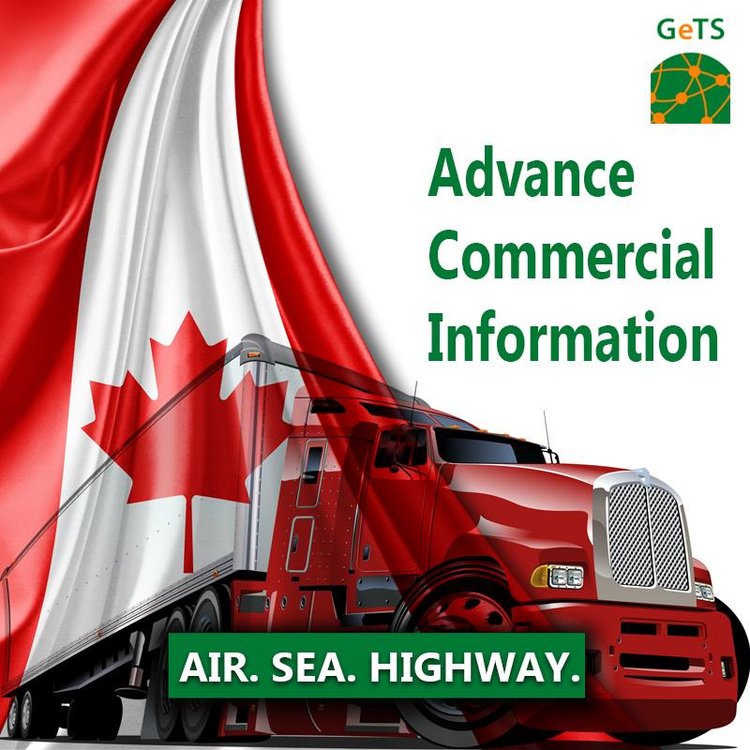Job Scam Alert:
This is to notify you that we have been alerted of job scams misusing the name of Global eTrade Services (GeTS). We would like to emphasize that there is no active, ongoing recruitment under the brand name of GeTS as we now operate under our parent company, CrimsonLogic. Please read the full disclaimer here.
- 28 Nov 2016
- Canada
- ACI
- ACI eManifest
- Canada eManifest
- Advance Commercial Information
- eHBL
- e-HBL
- CBSA
- Trade
- eManifest
- Border Crossing
On January 11, 2017, the transition period of the ACI eHBL implementation ends and the second phase begins. Are you ready for the next phase? During this period, the Canada Border Services Agency (CBSA) will start issuing warnings or zero-rated penalties (non-monetary) to freight forwarders deemed to be non-compliant. So it is best to start working toward full compliance right away. Here are some key points to help you along.
Canada eManifest Electronic House Bill: Voluntary Compliance Period
Since June 9, 2013, freight forwarders in all modes of transport have been able to submit advance house bill data for consolidated shipments using CBSA’s new electronic system. On May 6, 2015, the voluntary compliance period started and continues to remain in effect for freight forwarders. The CBSA will inform the community ahead of mandatory use and once the implementation timeline is confirmed. Until advance electronic house bill transmission becomes mandatory, electronic supplementary reports will be required in air and marine modes using the EDI system.

Once eHBL transmission becomes mandatory, freight forwarders in air and marine modes must submit supplementary cargo data for consolidated Freight Remaining on Board (FROB) only. Six months after the mandatory use date, penalties will apply for noncompliance. Client registration and testing notices are now available to EDI users, and certain notices will be available for testing in the eManifest Portal in fall 2016. The CBSA encourages freight forwarders to subscribe to the notices and prepare their systems for ACI eManifest e-HBL as early as possible.
What are the House Bill and Close Message data requirements?
The freight forwarder is required to submit house bills and Close Messages to CBSA within the mode-specific time frames. House Bills and Close Messages may be submitted to CBSA up to 90 days in advance.
House Bills – Mandatory Data Elements
Cargo Control Number (CCN)
Cargo description
Cargo quantity
Cargo quantity unit of measure
Carrier code
Consignee name
Consignee address line 1
Consignee city
Consignee country
Consolidation indicator (Yes/No)
Consolidator's name
Consolidator's Address Line 1
Consolidator’s city
Consolidator’s country
Freight forwarder name
Mode type
Movement type
Place of consolidation country
Port of Destination/Exit
Port of Destination/Exit Sub-location
Primary Cargo Control Number
Shipper Name
Shipper Address
Shipper City
Shipper Country
Total Cargo Weight
Total Cargo Weight Unit of Measure
Close Message – Mandatory Data Elements
Close Message Number
Freight Forwarder Name
List of Associated House Bill/s
What are the most frequent errors made in submitting House Bills?
Based on the electronic house bills and close messages submitted to CBSA so far, some of the most frequent errors are the following:
· e-HBL submitted after arrival of the shipment. Post-arrival submissions often require manual intervention by customs officials, which can lead to delays.
· Inaccurate or invalid port or destination codes. Some clients provide the airport code instead of the CBSA port code, leading to rejected e-HBLs. The CBSA urges freight forwarders to ensure that they are providing the appropriate port code.
· Incorrect consolidated freight indicator. If the checkbox next to the consolidated freight indicator is set to “Yes,” the freight forwarder must send a house bill close message as well as lower-level house bills. If the box is left unchecked or the shipment is non-consolidated, the freight forwarder must submit an associated release.
· Use of decimals in the eManifest Portal. The Portal does not accept decimal places in the weight and volume fields. Filers must use the closest whole unit number. For example, if the unit of measure is less than “1,” enter “1” in the fields.
The system checks for errors in the e-HBL transmission before sending it to the CBSA. If an error is detected, the submission will show “rejected” and the system will send an error message with a code indicating the reason for rejection. Clients can correct errors immediately and resend the corrected e-HBL transmission.
What is the CBSA’s compliance monitoring turnaround time?
For early adopters, the CBSA’s Compliance Monitoring Unit will review e-HBL transmissions to monitor compliance. Once a client has a sufficient number of e-HBL transmissions, CBSA will contact the client to review compliance. After the review, a report card will be issued to the client.
Export Shipments
Cargo departing or originating from Canada and cargo originating from the U.S. and departing from Canadian ports are considered export. eManifest will apply to most commercial goods entering Canada, except for shipments exported from Canada, full load postal shipments, and shipments cleared under the Courier Low-Value Shipment Program.
8000-Series Code
The freight forwarder must use their CBSA-issued, 8000-series freight forwarder code to submit an ACI eManifest e-HBL. The forwarder cannot use a marine carrier’s 9000-series code as CCN.
In-Transit Shipments
In-transit shipments or Canadian Origin In-transit (COI) are goods that leave Canada with the intention of re-entering Canada. The goods leave and re-enter the country under the same Cargo Control Document (CCD). Non-Canadian Origin In-transit (NCOI) are shipments that enter Canada with the intention of leaving the country. The shipment leaves Canada under the same CCD that was applied upon entry. CBSA will start tracing the shipment is departure is not confirmed within 40 days of entry into Canada. For consolidated in transit shipments, the freight forwarder must provide pre-arrival electronic house bill data, while the carrier must provide consolidated pre-arrival electronic cargo and conveyance data to CBSA.
Filing Advance Trade Data (ATD)
Clients do not need to be bonded with CBSA to submit ATD. To file ATD, you must be a CBSA-registered importer and have a Business Number (BN) issued by the Canada Revenue Agency. If the client is filing on behalf of an importer, a third party that will serve as the agent needs to be authorized by the CBSA. The importer retains all liability in terms of the ATD submission. All third parties filing on behalf of importers need written authorization from the CBSA.
Auto-Cancellation of Unused Cargo Control Numbers
Unused cargo control numbers (CCN) are stored in the CBSA system for specific time periods before being erased or transferred to a historical database. Non-arrived cargo data or cargo data that is transmitted but not used to report/arrive goods may be stored in the Accelerated Commercial Release Operations Support System (ACROSS) between 30 to 120 days (depending on the service option used) before being purged or archived.
CBSA aims to standardize the storage period of all non-arrived cargo data to 90 days (90 days after CBSA receives advance cargo data). ACROSS will automatically cancel all non-arrived cargo data, and the CBSA will notify the client and secondary notify party (SNP) of the auto-cancellation. This will allow the cancelled CCN to be reused. Until this time, current time frames apply.
What are Consolidated Shipments and Single Shipment requirements?
Single or non-consolidated shipments require the transmission of advance electronic cargo information to CBSA, including a CBSA-assigned carrier code and mandatory/conditional data elements such as shipper name and address, consignee name and address, detailed description of goods, and weight and pieces. The cargo data is based on the carrier’s bill of lading or ocean bill of lading and documentation in the carrier's records. A single bill of lading represents one shipment, one shipper and one consignee, but it may have data from multiple invoices.
A consolidated shipment, on the other hand, is separate shipments grouped together by a freight forwarder or consolidator and shipped to an agent or forwarder as one shipment. The consolidated shipment is under one bill of lading and reported to Customs on one cargo control document. Advance electronic cargo and house bill data are required, including mandatory data elements such as shipper name and address (foreign forwarder/consolidator), consignee name and address (Canadian forwarder/consolidator name and address), description of goods, and weight and pieces.
Carriers must select “Y” for the consolidated indicator to let customs know that house bill data is following. The freight forwarder or consolidator must also submit additional details of consolidated shipments in the e-HBL (or supplementary transmission for FROB in the air and marine modes). Mandatory data elements include shipper name and address, consignee name and address, description of goods, and weight and prices.
Is examination at first point of arrival mandatory?
Examination at the First Point of Arrival (FPOA) is currently not mandatory, but the CBSA may flag certain shipments or high-risk cargo at the FPOA. Low-risk shipments may be examined at an inland CBSA office or approved inland destination.
Post-Arrival Manual Corrections for House Bill, Cargo and Conveyance Data
Starting March 9, 2016, freight forwarders, warehouse operators, carriers and service providers must complete Form BSF673 to request post-arrival corrections to key data elements in the house bill, cargo and conveyance messages.
In-Bond Movement of Goods (End-State Electronic Process)
Carriers and freight forwarders who have filed security with the CBSA can now transport in-bond goods between points in Canada or to an inland destination. Shipments will continue to be granted in-bond movement as long as required pre-arrival information is submitted to CBSA within the specific time frames. Shipments will be allowed to move in-bond if the carrier and driver are members of a trusted trader program. If the carrier and driver are not members of a trusted trader program, the shipment cannot be moved in-bond until the importer data is submitted and assessed.
Currently, CBSA is developing a revised process for situations when importers in highway mode will be required to submit advance trade data. If the CBSA has evaluated the carrier’s pre-arrival cargo/conveyance data but has not received advance trade data, the shipment will be examined at the First Point of Arrival (FPOA).
Release at First Point of Arrival
The CBSA will not mandate release at the First Point of Arrival, and it will continue to urge importers and brokers to submit advance trade data for release (PARS or similar option).
Third-party Transmission of Importer Advance Trade Data Exception
Freight forwarders are required to submit advance house bill and supplementary cargo data in most situations. Under certain circumstances and when exceptions apply, the client must submit the appropriate exception code to CBSA. For example, when there is an exception to providing importer ATD, the freight forwarder or carrier can submit the ATD exception code on behalf of the importer if the forwarder/carrier has been authorized by the importer, and the forwarder/carrier submits the Manifest Forward recipient client identifier of the importer.
For more information, please visit our ACI eHBL page. You may also send us a message through the online form on our Contact Us page. We are here to help.
Related Pages
eManifest Canada: 10 Helpful Points in Choosing the Right ACE ACI Provider for your Business
The ACI eManifest Portal and your ACE ACI Services Provider
ACI Highway Canada eManifest FAQ
Simplifying the Filing Process with eManifest EDI Integration
Canada eManifest: Highway Shipments Made Easy
Mandatory Electronic Notification of Cargo Arrival FAQ with CrimsonLogic
ACI for Freight Forwarders (eHBL)
ACI eManifest Phase III: Canada eManifest House Bill Data & Supplementary Cargo Reports
ACI housebill eManifest: Bill of Lading for Freight Forwarders
